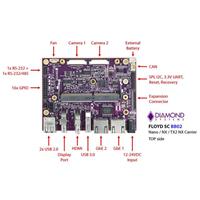FLOYD-SC Series, Embedded Computer Interface Boards
Results:
2
Manufacturer
Series
Expansion Site/Bus
Video Outputs
Ethernet
Operating Temperature
Watchdog Timer
USB
Size / Dimension
Digital I/O Lines
RS-232 (422, 485)
Analog Input
Function
Form Factor
Power (Watts)
Cooling Type
Results remaining:2
Applied Filters:
FLOYD-SC
About Embedded Computer Interface Boards
Embedded computer interface board products are modules that serve to enhance the functionality of small form factor computing devices, which are designed to be integrated into larger equipment. These interface boards provide additional features and capabilities, such as audio and video interfacing, high-speed network connectivity, GPS satellite reception, or wireless networking capability, to name a few examples. The purpose of these interface boards is to expand the capabilities of the embedded system by adding specific functionalities that may not be present on the core computing device. This allows for greater versatility and adaptability in various applications and industries. One important aspect of these interface boards is their form factor, which refers to their physical dimensions and layout. The form factors of these boards can be proprietary, meaning they are designed specifically for a particular system or manufacturer, or they can be based on open standards, allowing for greater compatibility and interchangeability across different devices and manufacturers. Proprietary form factors offer the advantage of being precisely tailored to the intended application, ensuring seamless integration and optimized performance. On the other hand, open standard form factors provide more flexibility and interoperability, allowing for easier integration with a wider range of devices and systems. These interface boards act as expansion modules that plug into the embedded computer, extending its capabilities beyond what is built-in. They typically connect to the core computing device through specialized connectors or interfaces, enabling the transfer of data, signals, and power between the two components. By utilizing embedded computer interface board products, designers and engineers can enhance the functionality of their embedded systems, enabling them to meet the specific requirements of different applications. These modules provide a means to integrate various functionalities seamlessly, expanding the possibilities and potential applications of the embedded system. In summary, embedded computer interface board products play a crucial role in adding functionality and expanding the capabilities of small form factor computing devices. Whether based on proprietary or open standard form factors, these modules enable the incorporation of specialized features into embedded systems, enhancing their performance and versatility in diverse industries and applications.


